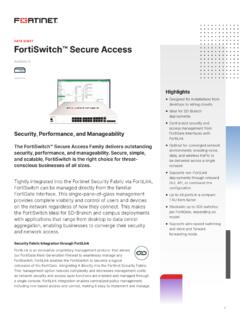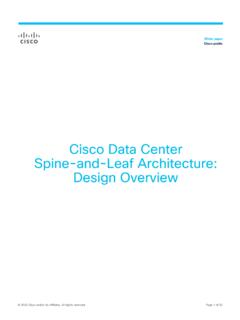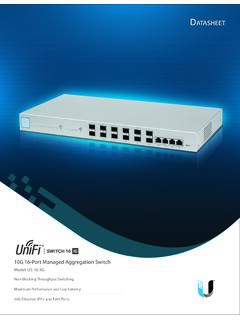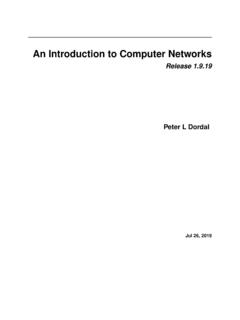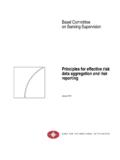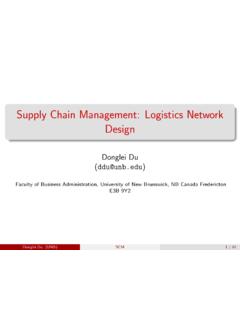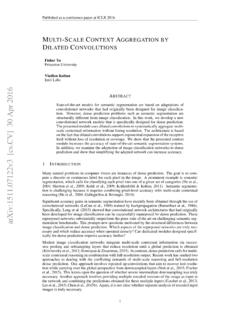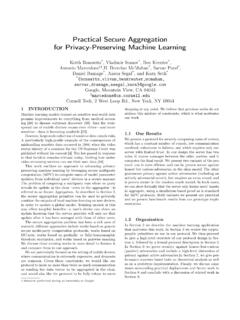Transcription of Deep Layer Aggregation - arXiv
1 Deep Layer AggregationFisher YuDequan WangEvan ShelhamerTrevor DarrellUC BerkeleyAbstractVisual recognition requires rich representations that spanlevels from low to high, scales from small to large, andresolutions from fine to coarse. Even with the depth of fea-tures in a convolutional network, a Layer in isolation is notenough: compounding and aggregating these representa-tions improves inference of what and where. Architecturalefforts are exploring many dimensions for network back-bones, designing deeper or wider architectures, but how tobest aggregate layers and blocks across a network deservesfurther attention. Although skip connections have been in-corporated to combine layers, these connections have been shallow themselves, and only fuse by simple, one-step op-erations. We augment standard architectures with deeperaggregation to better fuse information across layers. Ourdeep Layer Aggregation structures iteratively and hierarchi-cally merge the feature hierarchy to make networks withbetter accuracy and fewer parameters.
2 Experiments acrossarchitectures and tasks show that deep Layer aggregationimproves recognition and resolution compared to existingbranching and merging IntroductionRepresentation learning and transfer learning now per-meate computer vision as engines of recognition. The sim-ple fundamentals of compositionality and differentiabilitygive rise to an astonishing variety of deep architectures[23,39,37,16,47]. The rise of convolutional networksas the backbone of many visual tasks, ready for differentpurposes with the right task extensions and data [14,35,42],has made architecture search a central driver in sustainingprogress. The ever-increasing size and scope of networksnow directs effort into devising design patterns of modulesand connectivity patterns that can be assembled systemati-cally. This has yielded networks that are deeper and wider,but what about more closely connected?More nonlinearity, greater capacity, and larger receptivefields generally improve accuracy but can be problematicfor optimization and computation.
3 To overcome these bar-+Dense ConnectionsFeature PyramidsDeep Layer AggregationFigure 1: Deep Layer Aggregation unifies semantic and spa-tial fusion to better capture what and where. Our aggregationarchitectures encompass and extend densely connected net-works and feature pyramid networks with hierarchical anditerative skip connections that deepen the representation andrefine , different blocks or modules have been incorporatedto balance and temper these quantities, such as bottlenecksfor dimensionality reduction [29,39,17] or residual, gated,and concatenative connections for feature and gradient prop-agation [17,38,19]. Networks designed according to theseschemes have100+and even1000+ , further exploration is needed on how toconnect these layers and modules. Layered networks fromLeNet [26] through AlexNet [23] to ResNet [17] stack lay-ers and modules in sequence. Layerwise accuracy compar-isons [11,48,35], transferability analysis [44], and represen-tation visualization [48,46] show that deeper layers extractmore semantic and more global features, but these signs donot prove that the last Layer is the ultimate representationfor any task.
4 In fact, skip connections have proven effectivefor classification and regression [19,4] and more structuredtasks [15,35,30]. Aggregation , like depth and width, is acritical dimension of this work, we investigate how to aggregate layers tobetter fuse semantic and spatial information for recognitionand localization. Extending the shallow skip connectionsof current approaches, our Aggregation architectures incor-1 [ ] 4 Jan 2019porate more depth and sharing. We introduce two structuresfor deep Layer Aggregation (DLA): iterative deep aggrega-tion (IDA) and hierarchical deep Aggregation (HDA). Thesestructures are expressed through an architectural framework,independent of the choice of backbone, for compatibilitywith current and future networks. IDA focuses on fusingresolutions and scales while HDA focuses on merging fea-tures from all modules and channels. IDA follows the basehierarchy to refine resolution and aggregate scale stage-by-stage.
5 HDA assembles its own hierarchy of tree-structuredconnections that cross and merge stages to aggregate differ-ent levels of representation. Our schemes can be combinedto compound experiments evaluate deep Layer Aggregation acrossstandard architectures and tasks to extend ResNet [16]and ResNeXt [41] for large-scale image classification, fine-grained recognition, semantic segmentation, and boundarydetection. Our results show improvements in performance,parameter count, and memory usage over baseline ResNet,ResNeXT, and DenseNet architectures. DLA achieve state-of-the-art results among compact models for further architecting, the same networks obtain state-of-the-art results on several fine-grained recognition bench-marks. Recast for structured output by standard techniques,DLA achieves best-in-class accuracy on semantic segmenta-tion of Cityscapes [8] and state-of-the-art boundary detectionon PASCAL Boundaries [32]. Deep Layer Aggregation is ageneral and effective extension to deep visual Related WorkWe review architectures for visual recognition, highlightkey architectures for the Aggregation of hierarchical featuresand pyramidal scales, and connect these to our focus on deepaggregation across depths, scales, and accuracy of AlexNet [23] for image classificationon ILSVRC [34] signalled the importance of architecturefor visual recognition.
6 Deep learning diffused across vi-sion by establishing that networks could serve as backbones,which broadcast improvements not once but with every bet-ter architecture, through transfer learning [11,48] and meta-algorithms for object detection [14] and semantic segmenta-tion [35] that take the base architecture as an argument. Inthis way GoogLeNet [39] and VGG [39] improved accuracyon a variety of visual problems. Their patterned componentsprefigured a more systematic approach to design has delivered deeper and wider net-works such as residual networks (ResNets) [16] and high-way networks [38] for depth and ResNeXT [41] and Fractal-Net [25] for width. While these architectures all contributetheir own structural ideas, they incorporated bottlenecks andshortened paths inspired by earlier techniques. Network-in-network [29] demonstrated channel mixing as a techniqueto fuse features, control dimensionality, and go deeper. Thecompanion and auxiliary losses of deeply-supervised net-works [27] and GoogLeNet [39] showed that it helps to keeplearned layers and losses close.
7 For the most part these archi-tectures derive from innovations in connectivity: skipping,gating, branching, and Aggregation architectures are most closely related toleading approaches for fusing feature hierarchies. The keyaxes of fusion are semantic and spatial. Semantic fusion, oraggregating across channels and depths, improves inferenceof what. Spatial fusion, or aggregating across resolutions andscales, improves inference of where. Deep Layer aggregationcan be seen as the union of both forms of connected networks (DenseNets) [19] are thedominant family of architectures for semantic fusion, de-signed to better propagate features and losses through skipconnections that concatenate all the layers in stages. Ourhierarchical deep Aggregation shares the same insight on theimportance of short paths and re-use, and extends skip con-nections with trees that cross stages and deeper fusion thanconcatenation. Densely connected and deeply aggregatednetworks achieve more accuracy as well as better parameterand memory pyramid networks (FPNs) [30] are the dominantfamily of architectures for spatial fusion, designed to equal-ize resolution and standardize semantics across the levels ofa pyramidal feature hierarchy through top-down and lateralconnections.
8 Our iterative deep Aggregation likewise raisesresolution, but further deepens the representation by non-linear and progressive fusion. FPN connections are linearand earlier levels are not aggregated more to counter theirrelative semantic weakness. Pyramidal and deeply aggre-gated networks are better able to resolve what and where forstructured output Deep Layer AggregationWe define Aggregation as the combination of differentlayers throughout a network. In this work we focus on afamily of architectures for the effective Aggregation of depths,resolutions, and scales. We call a group of aggregationsdeepif it is compositional, nonlinear, and the earliest aggregatedlayer passes through multiple networks can contain many layers and connections,modular design helps counter complexity by grouping andrepetition. Layers are grouped into blocks, which are thengrouped into stages by their feature resolution. We are con-cerned with aggregating the blocks and Iterative Deep AggregationIterative deep Aggregation follows the iterated stackingof the backbone architecture.
9 We divide the stacked blocksof the network into stages according to feature stages are more semantic but spatially coarser. Skipconnections from shallower to deeper stages merge scalesINOUTB lockAggregation NodeStageINOUTINOUTINOUTINOUTINOUT(d) Tree-structured Aggregation (e) Reentrant Aggregation (c) Iterative deep Aggregation (a) No Aggregation (b) Shallow Aggregation (f) Hierarchical deep aggregationExistingProposedFigure 2: Different approaches to Aggregation . (a) composes blocks without Aggregation as is the default for classificationand regression networks. (b) combines parts of the network with skip connections, as is commonly used for tasks likesegmentation and detection, but does so only shallowly by merging earlier parts in a single step each. We propose two deepaggregation architectures: (c) aggregates iteratively by reordering the skip connections of (b) such that the shallowest partsare aggregated the most for further processing and (d) aggregates hierarchically through a tree structure of blocks to betterspan the feature hierarchy of the network across different depths.
10 (e) and (f) are refinements of (d) that deepen Aggregation byrouting intermediate aggregations back into the network and improve efficiency by merging successive aggregations at thesame depth. Our experiments show the advantages of (c) and (f) for recognition and resolutions. However, the skips in existing work, [35], U-Net [33], and FPN [30], are linear and aggre-gate the shallowest layers the least, as shown in Figure 2(b).We propose to instead progressively aggregate and deepenthe representation with IDA. Aggregation begins at the shal-lowest, smallest scale and then iteratively merges deeper,larger scales. In this way shallow features are refined asthey are propagated through different stages of 2(c) shows the structure of iterative deep Aggregation functionIfor a seriesof layersx1,..,xnwith increasingly deeper and semanticinformation is formulated asI(x1,..,xn) ={x1ifn= 1I(N(x1,x2),..,xn)otherwise,(1)whereNis the Aggregation Hierarchical Deep AggregationHierarchical deep Aggregation merges blocks and stagesin a tree to preserve and combine feature channels.}
![arXiv:0706.3639v1 [cs.AI] 25 Jun 2007](/cache/preview/4/1/3/9/3/1/4/b/thumb-4139314b93ef86b7b4c2d05ebcc88e46.jpg)

![arXiv:1301.3781v3 [cs.CL] 7 Sep 2013](/cache/preview/4/d/5/0/4/3/4/0/thumb-4d504340120163c0bdf3f4678d8d217f.jpg)
![@google.com arXiv:1609.03499v2 [cs.SD] 19 Sep 2016](/cache/preview/c/3/4/9/4/6/9/b/thumb-c349469b499107d21e221f2ac908f8b2.jpg)






